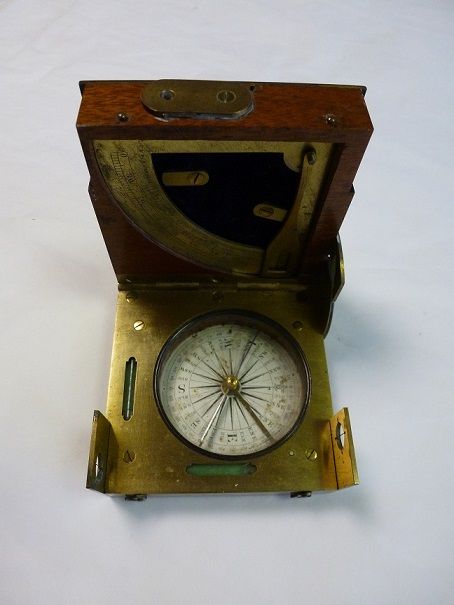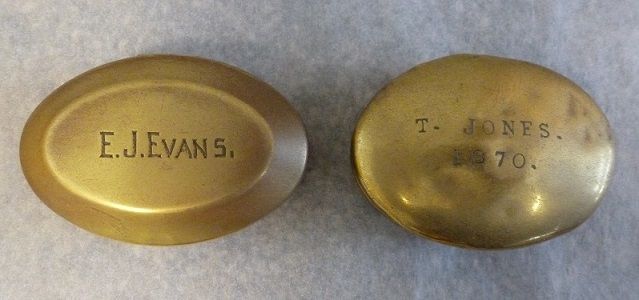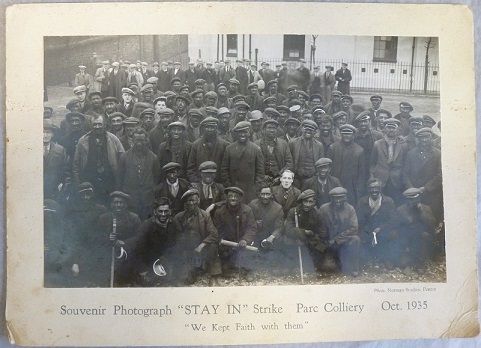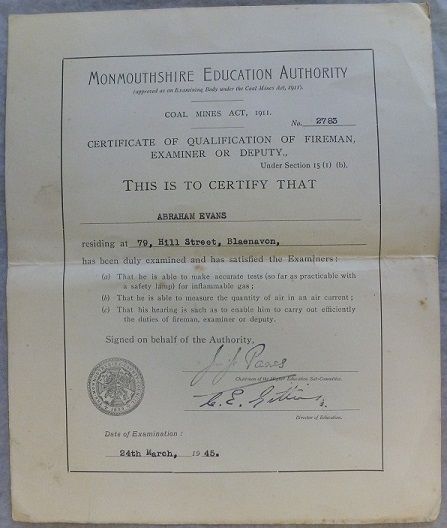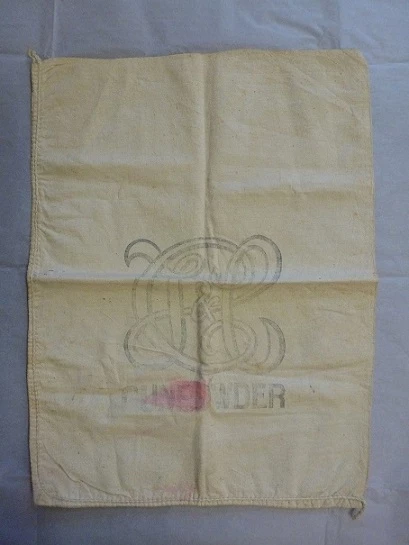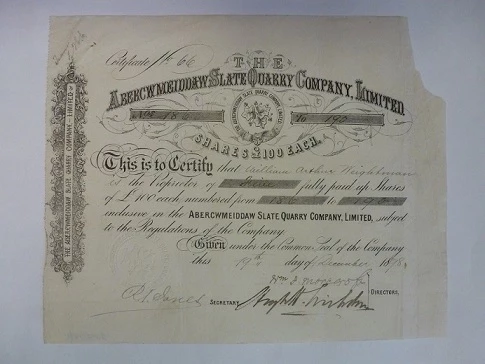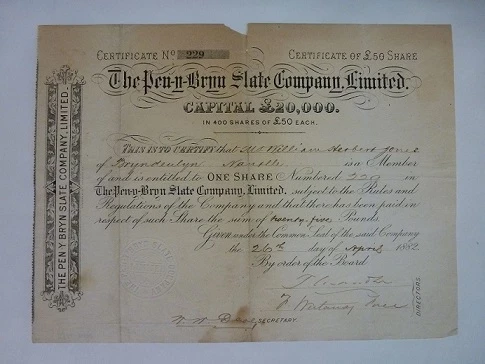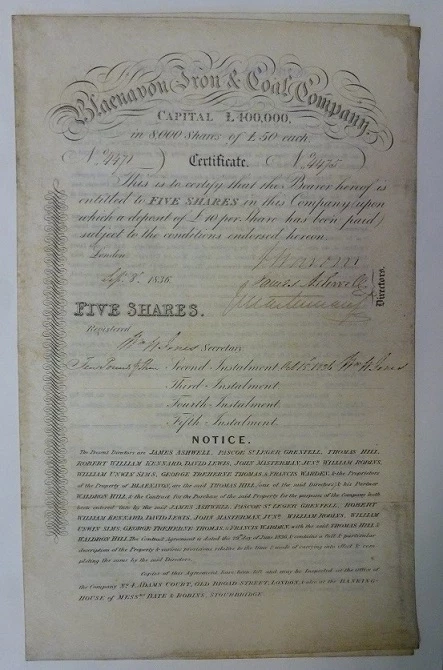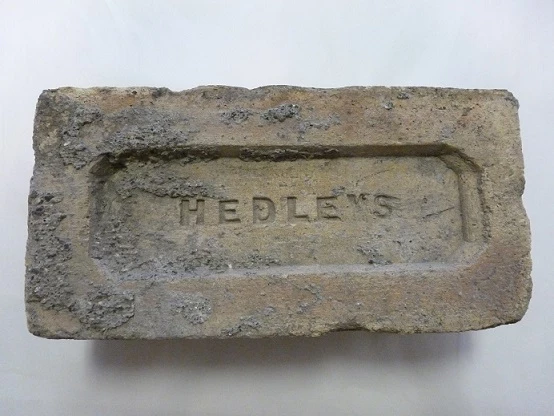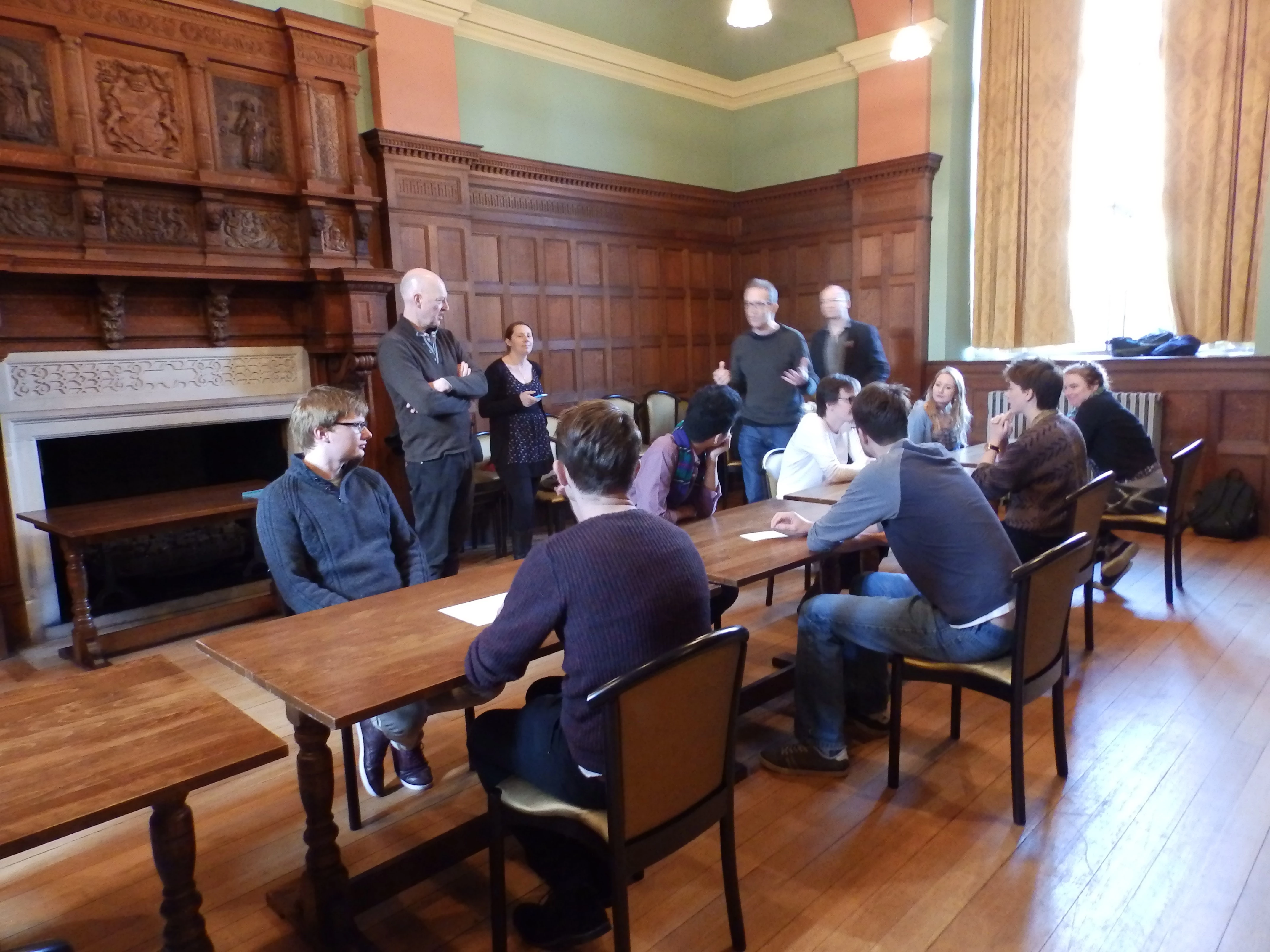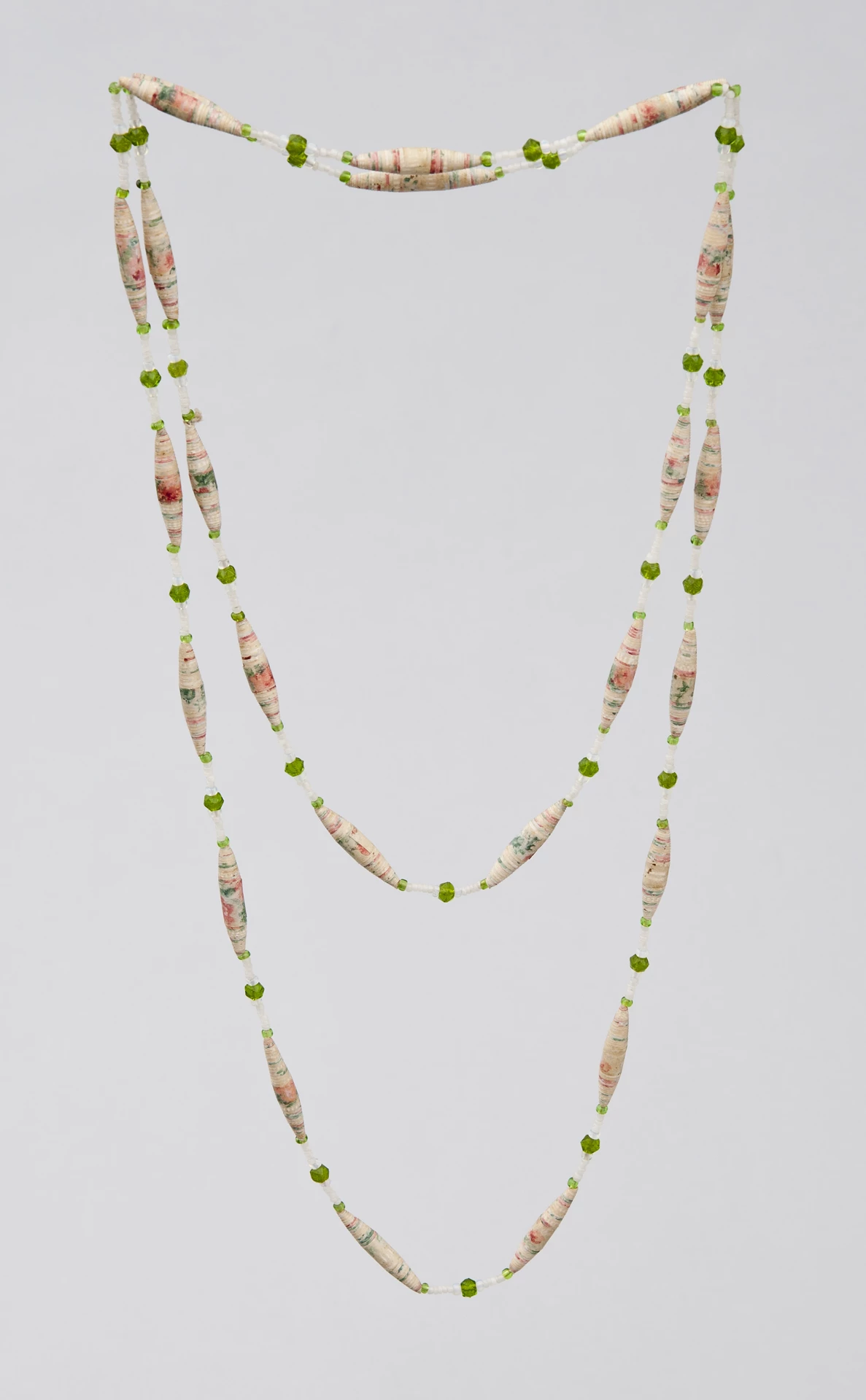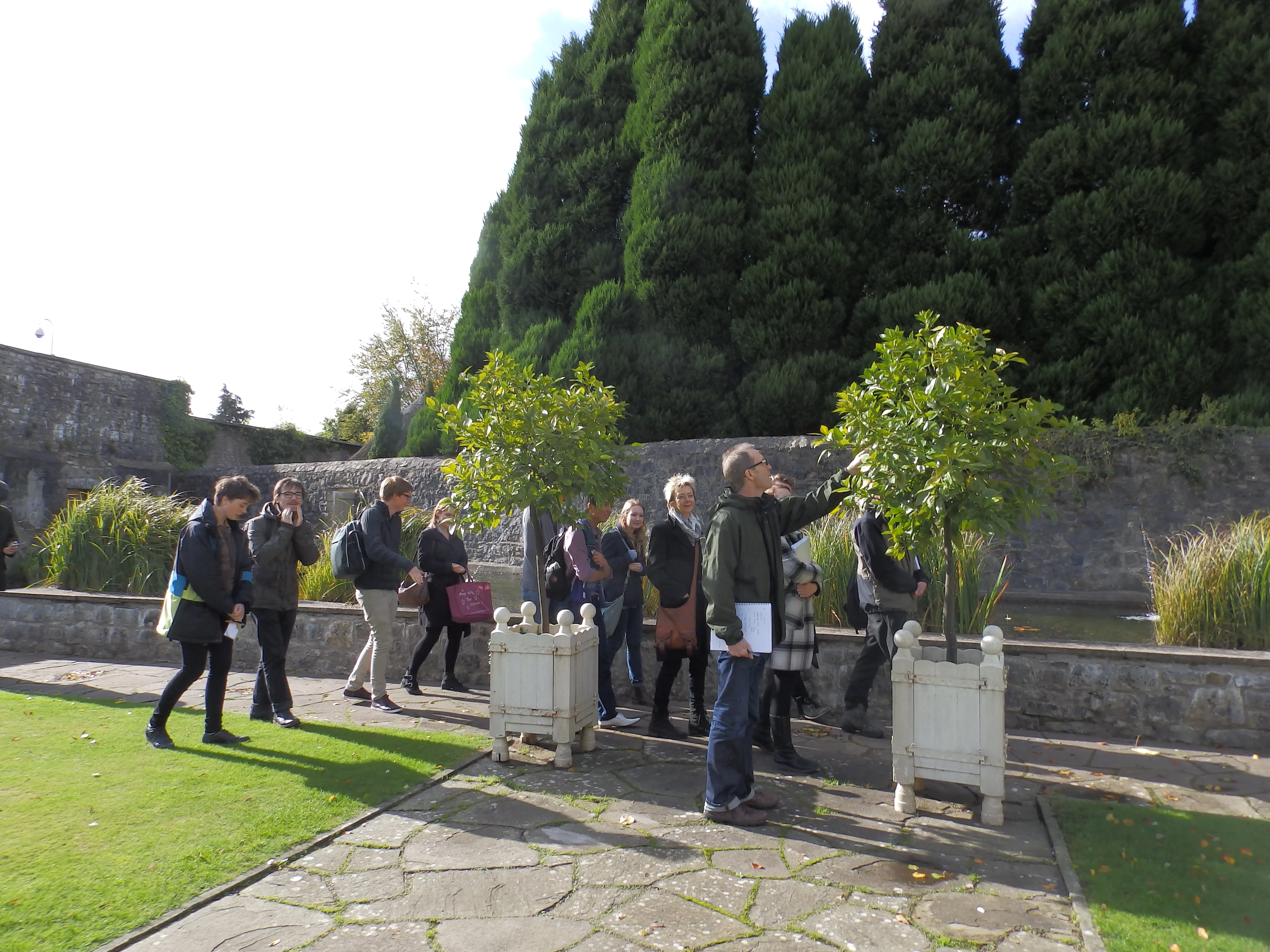Buom yn ffodus iawn ym mis Hydref o dderbyn yn rhodd y bag powdwr gwn diddorol hwn a ddefnyddiwyd yn ffatri Curtis's and Harvey Ltd. yng Nglyn-nedd. Mae eu monogram i’w weld ar flaen y bag. Cafodd ei ddefnyddio gan Elizabeth Thomas, hen famgu y rhoddwr. Dyma hi’n gadael yr ysgol yn 14 oed i weithio ar fferm, cyn mynd i weithio yn y ffatri powdwr gwn yn ystod y Rhyfel Byd Cyntaf. Mae’r rhodd amser yn berffaith ar gyfer arddangosfa Gwaith a Buddugoliaeth: Diwydiant Cymru a’r Rhyfel Byd Cyntaf yn Amgueddfa Genedlaethol y Glannau, Abertawe sydd ar agor tan 15 Mawrth 2015.
Yn ystod y mis prynwyd tair tystysgrif ar gyfer ein casgliad pwysig o dystysgrifau cyfranddaliadau Cymreig.
Mae’r cyntaf am bum cyfran gwerth £100 yng nghwmni Abercwmeiddaw Slate Quarry Company Limited ac yn dyddio o 1898. Cofrestrwyd y cwmni yn Lerpwl ym 1876 i gaffael chwarel llechi o’r un enw yng Nghorris a agorwyd yn y 1840au. Roedd y cwmni canolig ei faint yn cyflogi 188 o ddynion ym 1882 ac yn cynhyrchu 4,000 tunnell o lechi, ond cafodd ei ddirwyn i ben ym 1905 gyda’r lleihad yn y galw am gynnyrch Cymru. Sefydlwyd cwmni ag enw tebyg ym 1911 wrth ailagor y chwarel ar raddfa lai, cyn i hwnnw ddod i ben ym 1938.
Mae’r ail yn dystysgrif am gyfran gwerth £50 yn y Pen-y-Bryn Slate Company Limited, yn dyddio o 1882. Cofrestrwyd y cwmni ym 1881 i gaffael chwareli llechi yn Nantlle a agorwyd gyntaf yn y ddeunawfed ganrif a’u rhedeg ar raddfa fawr ers y 1830au. Cwmni canolig cyffredin oedd hwn yn rhedeg pedwar chwarel dan law Blondins mewn dull oedd yn nodweddiadol o Ddyffryn Nantlle. Ym 1883 roedd yn cyflogi 240 o ddynion ac yn cynhyrchu 5,000 tunnell o lechi. Aeth y cwmni i’r wal ym 1887 a caewyd y chwarel tan 1895 pan gafodd ei ailagor ar raddfa lai a’i weithio tan y 1940au.
Mae’r dystysgrif olaf wedi’i hargraffu ar femrwn – cyfran gwerth £50 yn y Blaenavon Iron & Coal Company, wedi’i dyddio ar 8 Medi 1836. Sefydlwyd y cwmni cyfranddaliadau cyfun cynnar hwn (gyda chyfalaf anferth o £40,000) i gaffael gweithfeydd haearn a glofeydd y teulu Hill a’u partneriaid. Dyma’r cwmni newydd yn ehangu’n sylweddol ar y gwaith gan agor gwaith newydd Ger yr Efail, adeiladu nifer o dai a chyflwyno trenau stêm. Tyfodd y gweithfeydd yn un o brif gynhyrchwyr dur Prydain a daeth yn gwmni atebol cyfyngedig ym 1864.
Ar 26 Awst 1892 lladdwyd 112 o ddynion a bechgyn mewn ffrwydrad yng Nglofa Slip. Mae’r caffaeliad newydd hwn yn un o ddau lyfryn o lythyrau ar gyfer Cronfa Gymorth Ffrwydrad Tondu (Caerdydd) fyddai wedi cael eu dosbarthu i godi arian. Cawsant eu dyddio yn Neuadd y Ddinas Caerdydd ar 3 Medi 1892.
Mae gennym gasgliad bychan o wrthrychau a ffotograffau yn ymwneud â’r digwyddiad gan gynnwys mwg coffa
Cynhyrchwyd y fricsen hon yn un o lofeydd y brodyr Hedley, mwy na thebyg yn ardal Bryncoch. Cafodd ei achub o’r adeilad a elwir yn Ysgoldy Sant Pedr ar Ffordd Aberhonddu, Abertawe. Amgueddfa Cymru yw ceidwad casgliad briciau cenedlaethol Cymru, ac mae hwn yn atodiad gwerthfawr.
Llathen fesur swyddogol (neu Ffon y Dirprwy) yw’r gwrthrych olaf y mis hwn. Cai ei defnyddio gan Reolwr Bwrdd Glo Cenedlaethol olaf Big Pit cyn i’r pwll gau ym 1979. Byddai swyddogion yn cario llathen fesur ac yn ei ddefnyddio i brofi am nwy. Cyn y 1960au byddai’r Dirprwy yn gallu hongian ei lamp drwy’r twll yn un pen a’i chodi i’r nenfwd i brofi am nwy. Yn ddiweddarach byddai falf samplo arbennig yn cael ei ffitio i fferel ar ben arall y llathen, a byddai hwn yn cael ei ddefnyddio i roi sampl nwy o fwlb samplo mewn lamp ddiogelwch Garforth.
Mark Etheridge
Curadur: Diwydiant a Thrafnidiaeth
Dilynwch ni ar twitter - @IndustryACNMW
